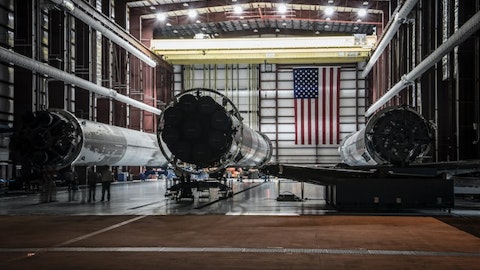Operator: Our next question comes from Kevin Chiang with CIBC. Please proceed.
Kevin Chiang: Maybe just turning back to Defense. Maybe if I look at it at a high level — and I know this math is overly simplistic. But if I just look at your run rate, I guess, adjusted segmented operating income and I look at the capital employed into Defense, your returns are kind of 3%, 4%. Presumably, with margins double or a little bit more than double, you’ll get high single-digit returns on that capital employed. That still feels like relatively low to me, just thinking about the margin cadence you’ve kind of laid out over the medium term. Just wondering, how do you think about driving that return higher? Is it kind of being able to grow revenue while keeping that capital employed relatively static? Do margins need to actually get closer to the mid-teens over time to — to maybe drive better returns? Just trying to think of the cadence of the return — the returns on capital here over — maybe over a longer period of time.
Marc Parent: Well, as I said, over a long period of time, we feel very comfortable about the service and — and achieving the target that we’ve given of low double-digit margins. And look, it’s clear that we’re not where we want to be today. We’d rather not be here, but it’s finite, it’s temporary. It’s not reflective of the long-term potential business. And again, the same factors are at play here. I mean, really, the two overall factors that are were. Number one, it’s on risk retirement. And risk retirement on what we call these drag programs, and we’re making progress. In some cases, we’re actually moving to accelerated. I can tell you, like in this past quarter, there were a few programs that we’ve shifted to 7-day work weeks to basically accelerate the schedule and get this behind us.
Obviously, when we do that, we encourage the cost, but I think it’s worth it to make sure that we exercise contractual opportunity obligation to meet the schedule on those contracts. In the case of new programs, as I talked about during my remarks, we remain very bullish about the profitability of those new programs we’re winning for all kinds of reasons. And such as something that I’ve talked about on previous calls, like being able to leverage and exercise what we call commercial rates on government contracts. And that don’t — it’s going to be a mix of programs. But in aggregate, the [indiscernible] of all those new programs that we’re winning are very — they are very accretive to the margin obligation that we did. So that’s really what’s happening here.
And as I said, where we are today on those transformational programs. Again, in the second half, they make only 3% of our revenue. Next year, that’s probably going to be about 15%. And obviously, accelerating as we go through the year. As you get into the end of the year, you’re going to have more of — basically, the revenue has been driven throughout the business, that’s going to be from those transformational programs. And at the same time, we’ll be substantially down the curve of retiring the risk on the drag program. So that’s where what’s at play here. And of course, what’s affecting those two trend lines are some of the factors I talked about, like basically contracts moving to the right in terms of us being able to execute on a contract or in a lot of cases, no fault of our own, if I should say, like in some cases, we’ve been selected for training contracts, but we’ve been delayed as much as six months because the customer is not getting the airplanes on time because the OEMs have been themselves affected by supply chain challenges that are not able to meet the production rates.
And of course, that means delays for us. So, all of those factors are at play here. But again, from a long-term standpoint, we feel very comfortable about the business.
Kevin Chiang: I appreciate the color there, Marc. Maybe just trying to Civil, we’ve been reading more — obviously, there’s a pilot shortage, and airlines are doing all they can to fill that backlog here. One of the things we’re reading about is just the advancements of pilots, pilots are moving first officers to captain much faster. And I’m just wondering, does that create more training opportunities for you? Does that shift how you think about wet versus dry hours? Like if an individual can kind of move to their career faster than maybe what it looked like pre-pandemic, does that impact maybe the mix of that commercial revenue between wet and dry or even the number of events you’re typically seeing over a one-year period with an airline or with a specific pilot?
Marc Parent: Well, I think it does a few things. I think first of all, to your question about anything that causes a pilot to change airplanes or change their position from being a first officer to being a captain, then by necessity and by regulation, and that’s on a global basis, requires retraining. And our business is training, and we’re by far the largest in the world. So obviously, that’s going to be a first order catalyst for us. So, for us, it’s a positive catalyst for our business. There is no doubt about that. The other component about this is that we — this — the growth — everyone is focused, as you would expect to make sure that we do that safely. Everything is [indiscernible] that basically plays to CAE’s strength because no one trains more pilots in the world than we do.



